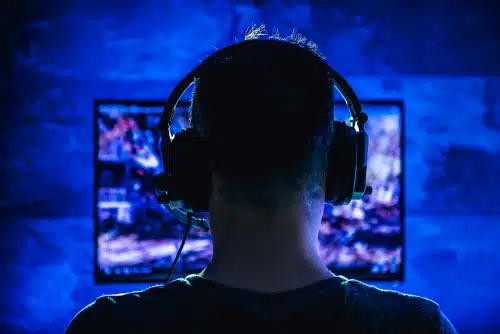
How Microtransactions Feed the Video Game Addiction
Over the last several decades, video games have begun to develop a bit of a bad reputation. Early on, when console gaming first became a thing, many video games were relatively benign. Role-playing games such as Dungeons and Dragons, BattleTech, and World of Warcraft would remain relegated to in-person experiences often played out for hours over the weekends between friends. However, technology would soon advance. A couple of decades ago, Blizzard Entertainment brought World of Warcraft to the Internet and opened up online role-playing gaming to the world. While World of Warcraft was not the first online MMORPG (Massive Multiplayer Online Role-Playing Game), it has stood the test of time for nearly thirty years. World of Warcraft, StarCraft, Battlefront, ROBLOX, and other games that share similar characteristics have been accused of feeding video game addiction among adults and teens alike. Some are quick to point out that video games should be held responsible for a host of difficulties faced by upcoming generations. Others question the existence of video game addiction at all.
What is Video Game Addiction?
Across the nation, as many as 60% of Americans play video games. Among adolescents and teens between age twelve and seventeen, that number increases to over ninety-five percent. Addiction to video games and (possibly) dependence on the community’s social outlet created as part of the gaming world affects millions of gamers of all ages. Indeed, it is possible to find benefits of video gameplay. For some, video games allow for social interaction and camaraderie that is not possible (for various reasons) outside of the digital world. In 2014, Blizzard Entertainment produced a documentary about this phenomenon entitled Looking for Group (anyone can easily find it on YouTube) that provided interesting insights into how video games have opened up a world once closed off for many.
Unfortunately, there are negatives to video gameplay as well. It is estimated that as many as 8% of children and teens are addicted to video games. Problematic video gameplay or video game addiction is the term used to describe circumstances where gaming leads to functional impairment in daily life. It is further explained as “an excessive and compulsive use of a computer or video games that results in social and/or emotional problems; despite these problems, the gamer is unable to control this excessive use.”
What are Microtransactions?
When someone downloads a game to their laptop, desktop, tablet, or phone, there is often a warning associated with the download that indicates the game features “in-app” or “in-game” purchases. These are called microtransactions. Microtransactions are events that occur within the game that offer the user positive feedback. Microtransactions are often used to generate revenue for free games (a game that does not require a fee to buy or download). For example, in ROBLOX, users can pay to get unique items, or in Candy Crush, players can pay for additional moves to be used after they have exhausted their free moves for the day. Microtransactions stimulate gamers in much the same way as drinking alcohol or using drugs stimulates an addiction. Microtransactions entice gamers (some who may be too young to understand the consequences of their actions) to spend money to obtain an advantage in whatever game they’re playing. Often, microtransactions only cost a few dollars, which, in the short term, does not seem like much.
Before long, a few dollars morphs into hundreds of dollars per month as the desire to gain a competitive edge or win at whatever cost overtakes the gamer’s sensibility about what they’re spending. Microtransactions are even more harmful to younger children as they may not be cognitively equipped to understand what they are doing, how much money they’re spending, or that the money is real. The consequences of their actions sometimes do not come to light until mom or dad receive their credit card bill weeks later.
Perhaps even more frustrating for teen gamers and parents of teen gamers alike is the frequency with which “free games” are now building in ads that the user can conveniently remove through the use of microtransactions. The ads pop up on the sides of the screen or the bottom of the screen, often to a frequency that grows annoying enough to inspire the gamer to click a link and process the microtransaction to make the ads go away. Several theories suggest using microtransactions in the gaming industry can lead to gambling addictions or gaming addictions based on how the user interacts with the microtransaction.
Video Games, Movies and Gambling – How They are Similar
Part of the reason adolescents and teens (and adults) easily become addicted to video games lives in the similarities between video games and gambling. Although people do not often equate video games with gambling, they are quite similar in many ways. Video games and gambling both offer a schedule of reinforcement to inspire users to purchase items or bonuses to prolong the gaming experience. This system of rewards and bonuses is cyclical, meaning that the user will continue to extend the process of purchase and use so long as they continue to get rewarded and can continue their gaming experience. In the case of gaming, the user will purchase a perk or benefit that allows them to prolong the gaming experience. Once the gaming experience is about to come to an end, they will again buy a bonus or reward to continue the gaming experience. Also, video games like slot machines use animation, lights, or other types of stimulation to reinforce the user’s desire to play positively.
As video games become more complicated and technologically advanced, so do the storylines that inspire the video game. As the gamer continues to play in the storyline continues to evolve, it is only natural that the gamer will want to see the story through to the end outcome. When the result is positive, they will want more, so they are likely to start the process repeatedly. Also, when the outcome is not how they wanted, they will start the process over again to change the final outcome of the game. Over time, the idea of just one more round or just one more game takes over the gamer’s life in detrimental ways.
What Are the Impacts of Video Game Addiction?
Video game addiction, like many other addictions, can result in various physical and psychological health impacts. First, someone who has developed an addiction to video games is likely to experience various negative mental health impacts. These can include anxiety, depression, and family difficulties. Anxiety is experienced when the gamer is unable to complete a level. Experiences defeat in a challenging task or is unable to play as long for when they want to. Depression can result for similar reasons. Although, as noted above, there are social benefits to the online gaming community, there can be detrimental mental health impacts when an adolescent or teen lives solely in an online world.
Video game addiction can also impart significant health effects on individuals who spend too much time playing video games. First, excessive video gameplay often leads to a sedentary lifestyle. This lifestyle is often devoid of physical activity and exercise, leading to weight gain and poor nutrition and poor posture, back and neck difficulties. Some adolescents and teens will struggle with in-person social relationships.
While they may be able to actively communicate with the online community that shares a common interest, they may struggle to make friendships outside of that community. Also, they may find it challenging to concentrate and pay attention to other tasks such as work in school as the pull of video games in the “need” to achieve just one more level become stronger the need to complete their obligations.
In some cases, although far less common, repeated screen time exposure, especially to loud noises and bright lights, can cause or exacerbate seizures in those who are prone to them or who have a diagnosed seizure disorder. Some individuals may even develop carpal tunnel and wrist or hand issues from frequent use of computer keyboards or remote controls.
Treatment for Video Game Addiction
The Diagnostic and Statistical Manual of Mental Disorders (DSM) is often considered the “gold standard” diagnostic guide within the mental community. Unfortunately, video game addiction has yet to be regarded as a formal diagnosis in the DSM. However, it does provide diagnostic criteria for a gambling addiction which, as noted above, shares many similar symptoms to video game addiction. Because video game addiction does not have listed diagnostic criteria, there is a limited body of research that provides support and guidance for treatment. However, this does not mean that video game addictions are without remedy. Because video game addiction often presents symptoms similar to other addictive behaviors, similar treatments have shown to be successful. Behavior modification treatments such as cognitive behavioral therapy and 12 step recovery programs are often used to help adolescents and teens understand the root causes of addictive behavior and in healthier ways to manage their behaviors.
The goal of cognitive behavioral therapy is to help the patient examine their behaviors to better understand why they occur. Once they can understand their thoughts (in this case, around video games) and think about them carefully, they can learn ways to change their beliefs about excessive video gameplay and how to still play video games but in a healthier way.
During therapy sessions, a participant will learn about behavioral modifications such as play limitations, reduction in playing, or eliminating gaming altogether. Together with their therapist, they would find ways to set healthy and attainable goals and work towards reaching them.
There are many treatment options to choose from when it comes to addiction treatment in general. If you or a loved one are struggling with addiction to gaming, reach out to the caring and compassionate team at Beachside today. Without treatment, excessive video gameplay or use of microtransactions can lead not only to detrimental health impacts but significant financial consequences. The Beachside team is here to help your family learn more about how our programs can help with video game addiction.
Sources




